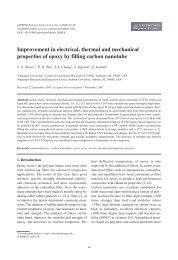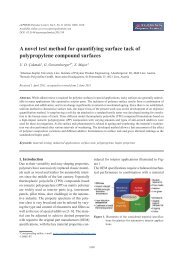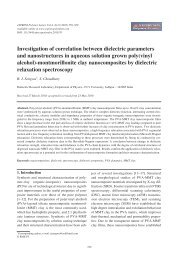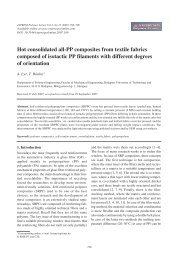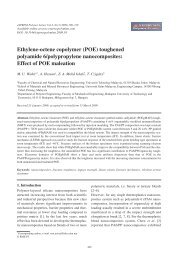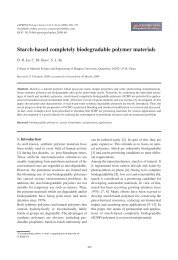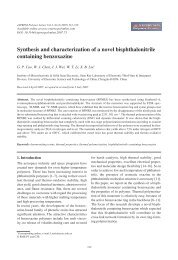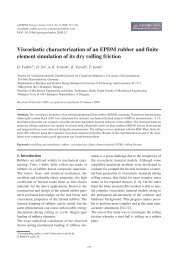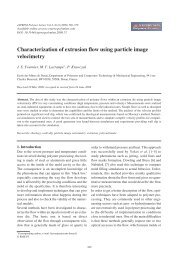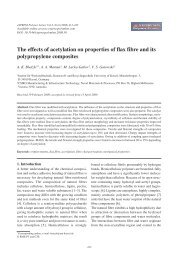Nanotechnology and its applications in lignocellulosic composites, a ...
Nanotechnology and its applications in lignocellulosic composites, a ...
Nanotechnology and its applications in lignocellulosic composites, a ...
Create successful ePaper yourself
Turn your PDF publications into a flip-book with our unique Google optimized e-Paper software.
Kamel – eXPRESS Polymer Letters Vol.1, No.9 (2007) 546–575<br />
ified montmorillonite was prepared by melt <strong>in</strong>tercalation<br />
method even at 5% filler content. Thus, the<br />
preparation method might have an effect on the<br />
properties. Composites have been prepared by solution<br />
method after dry<strong>in</strong>g of starch <strong>and</strong> clay at<br />
110°C. All <strong>composites</strong> show highest weight loss at<br />
296°C. It was assumed that thermal degradation<br />
was <strong>in</strong>fluenced by hydroxyl group exposure, clay<br />
dispersion <strong>and</strong> reassociation of starch cha<strong>in</strong>s where<br />
clay dispersion was more important than others<br />
[140]. However, hydrophobic poly (lactic acid) <strong>and</strong><br />
hydrophilic starch are thermodynamically immiscible,<br />
lead<strong>in</strong>g to poor adhesion between the two components,<br />
<strong>and</strong> hence poor <strong>and</strong> irreproducible performance.<br />
Various compatibilizers <strong>and</strong> additives<br />
have been <strong>in</strong>vestigated to improve the <strong>in</strong>terfacial<br />
<strong>in</strong>teractions of these blends. Wang et al. [141, 142]<br />
used methylenediphenyl diisocyanate to improve<br />
the <strong>in</strong>terface <strong>and</strong> studied a blend of 55/45 w/w mixture<br />
of poly (lactic acid) <strong>and</strong> dried wheat starch <strong>in</strong><br />
an <strong>in</strong>tensive mixer with or without a low level of<br />
methylenediphenyl diisocyanate. Blends with methylenediphenyl<br />
diisocyanate had enhanced mechanical<br />
properties that could be expla<strong>in</strong>ed by the <strong>in</strong> situ<br />
formation of a block copolymer act<strong>in</strong>g as a compatibilizer.<br />
Scann<strong>in</strong>g electron microscopy showed<br />
reduced <strong>in</strong>terfacial tension between the two phases.<br />
The presence of methylenediphenyl diisocyanate<br />
also enhanced the mechanical properties of the<br />
blend at temperatures above T g . Water uptake by<br />
the poly (lactic acid)/ starch blends with <strong>and</strong> without<br />
methylenediphenyl diisocyanate did not differ.<br />
Wang et al. [143] also studied the effect of starch<br />
moisture content on the <strong>in</strong>terfacial <strong>in</strong>teraction of an<br />
equal-weight blend of wheat starch <strong>and</strong> poly (lactic<br />
acid) conta<strong>in</strong><strong>in</strong>g 0.5% methylenediphenyl diisocyanate<br />
by weight. Starch moisture (10–20%) had a<br />
negative effect on the <strong>in</strong>terfacial bond<strong>in</strong>g between<br />
starch <strong>and</strong> poly (lactic acid). The tensile strength<br />
<strong>and</strong> elongation of the blend both decreased as<br />
starch moisture content <strong>in</strong>creased. In blends of poly<br />
(lactic acid) /starch us<strong>in</strong>g dioctyl maleate as a compatibilizer<br />
markedly improved the tensile strength<br />
of the blend, even at low concentrations (below<br />
5%). When dioctyl maleate functioned as a plasticizer<br />
at concentrations over 5%, significant<br />
enhancement <strong>in</strong> elongation was observed. Compatibilization<br />
<strong>and</strong> plasticization took place simultaneously<br />
accord<strong>in</strong>g to the blends [144]. With dioctyl<br />
maleate as a polymeric plasticizer, thermal loss <strong>in</strong><br />
the blends was not significant. Water absorption of<br />
poly (lactic acid)/starch blends <strong>in</strong>creased with<br />
dioctyl maleate concentration. Other compatibilizers<br />
were also studied for the starch/poly (lactic<br />
acid) blends, such as poly (v<strong>in</strong>yl alcohol) [145] <strong>and</strong><br />
poly(hydroxyester ether) [146] it was added to a<br />
starch <strong>and</strong> poly (lactic acid) blend (50/50, w/w) to<br />
enhance compatibility <strong>and</strong> improve mechanical<br />
properties.<br />
4.5. Re<strong>in</strong>forc<strong>in</strong>g agent for polymer<br />
electrolytes for lithium batteries<br />
application<br />
Ion-conduct<strong>in</strong>g solid polymer electrolytes have<br />
attracted considerable <strong>in</strong>terest, because of their<br />
potential application <strong>in</strong> rechargeable batteries, fuel<br />
cells, light-emitt<strong>in</strong>g electrochemical cells, electrochromics,<br />
<strong>and</strong> many other electrochemical<br />
devices [147–149]. Cellulose crystallites <strong>in</strong> the<br />
form of microcrystall<strong>in</strong>e cellulose are currently utilized<br />
widely <strong>in</strong>dustrially. In the nanocomposite<br />
field, cellulose whiskers can be used as mechanical<br />
re<strong>in</strong>forc<strong>in</strong>g agents of low-thickness polymer electrolytes<br />
for lithium batteries application but, the<br />
filler content is generally relatively low, below<br />
10 wt%, avoid<strong>in</strong>g significant decrease of the ionic<br />
conductivity. Nanocomposite polymer electrolytes<br />
based on high-molecular weight poly (oxy ethylene)<br />
were prepared from high aspect ratio cellulose<br />
nanocrystall<strong>in</strong>e whiskers <strong>and</strong> lithium trifluoromethyl<br />
sulfonyl imide. The ma<strong>in</strong> effect of<br />
whisker is thermal stabilization of the modulus of<br />
<strong>composites</strong> above the melt<strong>in</strong>g po<strong>in</strong>t of the poly<br />
(oxy ethylene)/lithium trifluoro methyl sulfonyl<br />
imide complexes. The filler provides a high re<strong>in</strong>forc<strong>in</strong>g<br />
effect, while a high level of ionic conductivity<br />
is reta<strong>in</strong>ed with respect to unfilled polymer<br />
electrolytes. So the ionic conductivity was quite<br />
consistent with the specifications of lithium batteries<br />
[150, 151].<br />
To study the effect of cellulose whiskers on<br />
mechanical properties of nanocomposite an aqueous<br />
suspension of high aspect ratio rod-like cellulosic<br />
particles composed of tunic<strong>in</strong> whiskers <strong>and</strong> a<br />
poly (oxy ethylene) aqueous solution casted <strong>in</strong> a<br />
Petri dish. After water evaporation a solid composite<br />
film was obta<strong>in</strong>ed, the mechanical behavior of<br />
tunic<strong>in</strong> whiskers/poly (oxy ethylene) nano<strong>composites</strong><br />
was evaluated <strong>in</strong> the l<strong>in</strong>ear range over a broad<br />
temperature range from dynamic mechanical analysis.<br />
The ma<strong>in</strong> effect of the filler was a thermal sta-<br />
563




